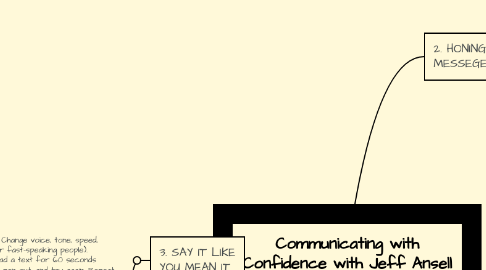Communicating with Confidence with Jeff Ansell
por Kate Kotenko Lengold


1. 3. SAY IT LIKE YOU MEAN IT
1.1. introduced to the universe they don’t go away. Change voice, tone, speed, inflections. Enunciate every word (challenge for fast-speaking people). Excercise — hold a pen between your teeth, read a text for 60 seconds trying to enunciate every word. Then, take the pen out, and try again. Repeat daily.
2. 1. BE A BETTER COMMUNICATOR
2.1. WHAT MAKES A GOOD SPEAKER. Look like you mean it and sound like you mean it. Confident communcator — grounded, natural. Connect through words, gestures and voice. 55% Visual (how you look) + 38% Vocal (how you sound) + 7% Verbal (what you say). You want to be vulnerable in front of others (personal stories, shared experience). Good speaker touches you. He is connected -- to himself and the audience.
2.2. WHAT HOLDS YOU BACK. One potential problem — high expectations (need to be perfect). Racing Brain Syndrome — what you are saying and thinking is out of sync. Don’t try hard — try easy. Endless Loop Trap — tossing information at people at a detached, disconnected manner. It shouldn’t be all about you.
2.3. CONNECTING WITH YOURSELF. Just because I say it people are going to get it — very wrong! We are thinking way too fast. Get out of your head. Center and connect.
2.4. CONNECTING WITH OTHERS. Every communication — two-way communication. One thought at one time, it keeps you in the present and allows you to align you gestures and facial expressions to your talking as well as react to the audience’s response. Be responsive at the moment.
2.5. BREATH PROPERLY. Never hold breath / do high chested breathing. You need oxigen. Breath with nose, belly in/out. Each breath 3-5 seconds.
3. 2. HONING YOU MESSEGE
3.1. Know what to say. Use simple words. Use short sentenses. Make your point and put a period. One thought - one time - one short sentense. Identify your desired outcome. Determine the words that illustrate how you want to be seen.
3.2. Organize your thoughts. Use index cards — capture one thought on each index card (remember, one thought at one time).
3.3. Introduction - Main Idea + Details + (…) + Conclusion + Call to Action
3.3.1. Define purpose of the presentation first (keep in mind what you want to accomplish with that presentation).
3.3.2. Main Idea: three-four major ideas. Avoid more than than 4. Each idea on a sepatate card.
3.3.3. Details: information relative to the audience, visual aids, demos, anecdotes.
3.3.4. Introduction: give people a reason to listen to you in 20 seconds to capture their attention. Give the single most important reason to listen to you. Open with energy and enthusiasm.
3.3.5. Conclusion: people remember the best. End the presentation in a clear way (never introduce new ideas). Leave your audience with one thought.
3.3.6. Call to Action: What do you want them to do next — e.g. I want your business.

